
An "Enharmonic Equivalent" is where a musical pitch can have different names depending on the context in which it is functioning. An example is G# produces the same pitch as Ab but have different standard notations when written in music.

TAB, short for tablature is a form of musical notation using numbers and letters on a staff that that corresponds to the number of strings of fretted string instrument. Theses number tell a player which fret to place their fingers on the fingerboard. TAB has a history with lute music from centuries ago and has found wide use in the music publishing industry catering to the guitarist who can?t or doesn't want to learn to read.

This series of lessons will allow you finally, to check that Reading item off your music To Do list. Learning to read standard music notation opens a world of music to you. Music notation is the Lingua franca of amateur and professional musicians alike.

Standard music notation, the natural, sharp and flat notes of the ukulele fingerboard for C tuned ukuleles. Covers both high C and low G tuning variations.

The D Tuning comes in two versions where string four is either tuned to the "A", a major second below string one or low "A" where string fours is a perfect fifth below string three. The D tuning with a low A is the same as the thin four strings of a standard tuned guitar with a capo at fret (7).

Cut Time is a source of confusion for many musicians. What exactly does it mean and how do you apply it? Here is a guest lesson by internationally renowned jazz guitarist and educator Chuck Anderson.

Traditional key signatures provide a wealth of information that can enhance our understanding of music and its underlying principles.

In music, it is important to learn and recognize the key signature for C Major and A Minor. These two keys have corresponding major and natural minor scales, along with basic ukulele chords that can be used with each scale. The key of C Major, also known as the learning key, is particularly easy to memorize and start using.
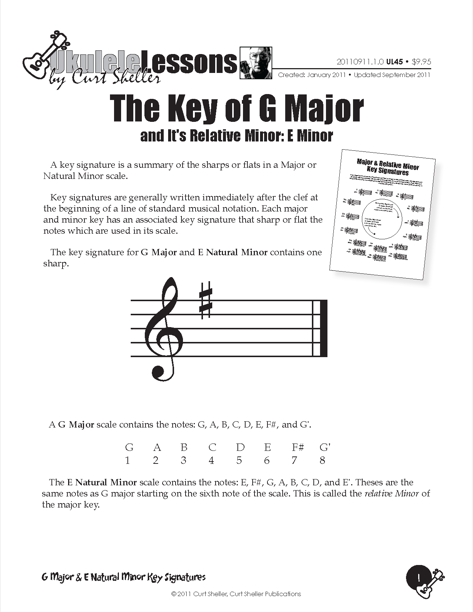
“G Major” (or the key of G) is a major scale based on G, with the pitches G A B C D E F#. Its key signature has one sharp: F#. Its Relative Minor scale is E Minor. Its Parallel Minor is D Minor.

"D Major" (or the key of D) is a major scale based on D, with the pitches E F# G A B C#. Its key signature has two sharps: F# C#. Its Relative Minor scale is Bm Minor. Its Parallel Minor is D Minor.

"A Major" (or the key of A) is a major scale based on A, with the pitches A B C# D E F# G#. Its key signature has three sharps: F# C# G#. Its Relative Minor scale is F# Minor, Minor. Its Parallel Minor is A Minor.

"E Major" (or the key of E) is a major scale based on E, with the pitches E F# G# a B C# D#. Its key signature has four sharps: F# C# G# D#. Its Relative Minor scale is B Minor. Its Parallel Minor is E Minor.

"B Major" (or the key of B) is a major scale based on B, with the pitches C# D# E F# G# A#. Its key signature has five sharps: F# C# G# D# A#. Its Relative Minor scale is G# Minor. Its Parallel Minor is B Minor and, its enharmonic equivalent is Cb minor.

"F# Major" (or the key of F#) is a major scale based on F#, with the pitches F# G# A# B C# D# E#. Its key signature has six sharps: F# C# G# D# A# E#. Its Relative Minor scale is G# Minor. Its Parallel Minor is F# Minor and, its enharmonic equivalent is Gb minor.

"C# Major" (or the key of C#) is a major scale based on C#, with the pitches, all sharps C# D# ES F# G# A#. Its key signature has seven sharps: F# C# G# D# A# E# B#. Its Relative Minor scale is A# Minor. Its Parallel Minor is C# Minor, and its enharmonic equivalent is Db minor. C# is a somewhat easy key and scale to memorize as all the note are sharp.

"F# Major" (or the key of F#) is a major scale based on F#, with the pitches F# G# A# B C# D# E#. Its key signature has six sharps: F# C# G# D# A# E#. Its Relative Minor scale is G# Minor. Its Parallel Minor is F# Minor and, its enharmonic equivalent is Gb minor.

"Bb Major" (or the key of Bb) is a major scale based on Bb, with the pitches Bb C D Eb F G A. Its key signature has two flats: Bb Eb. Its Relative Minor scale is G Minor. Its Parallel Minor is Bb Minor. B-flat major is a suitable key for most wind instruments, especially those for which it is their home key, such as clarinets, trumpets, tenor saxophone, soprano saxophone and flutes in B-flat.

"Eb Major" (or the key of Eb) is a major scale based on Eb, with the pitches Eb F G Ab Bb C D. Its key signature has three flats: Bb Eb Ab. Its Relative Minor scale is C Minor. Its Parallel Minor is Eb Minor. E flat major is often associated with bold, heroic music, in part because of Beethoven's usage.

"Ab Major" (or the key of Ab) is a major scale based on Ab, with the pitches Ab Bb C D Eb F G. Its key signature has four flats: Bb Eb Ab Db. Its Relative Minor scale is F Minor. Its Parallel Minor is Ab Minor.

"Db Major" (or the key of Db) is a major scale based on Db, with the pitches Db Eb F Gb Ab Bb C. Its key signature has five flats: Bb Eb Ab Db Gb. Its Relative Minor scale is Bb Minor. Its Parallel Minor is Db Minor.

"Gb Major" (or the key of Gb) is a major scale based on Gb, with the pitches Gb Ab Bb Cb Db Eb Ab F. Its key signature has six flats: Bb Eb Ab Db Gb Cc. Its Relative Minor scale is Eb Minor. Its Parallel Minor is Gb Minor, usually replaced by F-sharp minor, since G flat minor, which would have nine flats, is theoretically possible but is not typically used.

"Cb Major" (or the key of Cb) is a major scale centered around Cb, with the following pitches: Cb, Db, Eb, Fb, Gb, Ab, and Bb. The key signature of Cb Major includes seven flats: Bb, Eb, Ab, Db, Gb, Cb, and Fb. The relative minor scale of Cb Major is Ab Minor, while the parallel minor is Cb Minor. Cb Major is considered relatively easy to memorize, as all of its notes are flat.

What is up, down, higher, lower, top, bottom, ascending, descending on a guitar? Up, down, higher, lower, top, bottom, ascending, descending should refer to musical pitch and not to direction as we know it. Up and higher refers to the raising of musical pitch. Down and lower refer to the lowering of musical pitch. Top refers to the upper note of a chord voicing or musical phrase and bottom refers to the lowest note.

Just what is "Up, Down, Ascending, Descending, Higher, Lower, Top, Bottom" as related to music?

Music notation or musical notation refers to various systems of writing music. Diverse systems of musical notation have developed in various cultures. In fact, many cultures simply do not notate their music in any form.
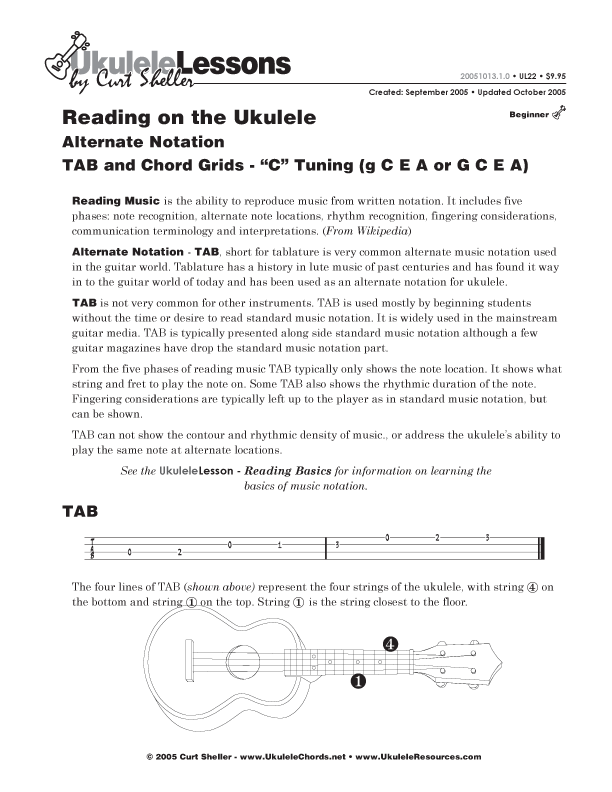
"TAB" or "Tablature", is an alternate form of musical notation, which tells players where to place their fingers on a particular instrument rather than which pitches to play. TAB is sort of a secret language between guitar players and ukulele players. Although a shortcut to getting started it actually serves to alienate one from the rest of the music world.

The QUICKSTART Rhythm Section CD contains 24 unique styles designed for contemporary lead guitar. Each track is devoted to a scale covered in the QUICKSTART Scale Fingerings series of books. There are four background tracks for each scale, featuring the chords of the scale. These tracks give you the opportunity to explore the sound of each scale in an improvisational setting.

Four premium practice play-along tracks for mastering and exploring the Ionian scale. Suitable for any instrument.

Four Premium practice play-along tracks for mastering and exploring the Aeolian scale. Suitable for any instrument.

Four Premium practice play-along tracks for mastering and exploring the Mixolydian scale. Suitable for any instrument.

Four Premium practice play-along tracks for mastering and exploring the Dorian scale. Suitable for any instrument.

Four Premium practice play-along tracks for mastering and exploring the Pentatonic scale and suitable for any instrument.

Four Premium practice play-along tracks for mastering and exploring the Blues scale. Suitable for any instrument.

"Modular Phonetic Rhythm" by Chuck Anderson represents a significant advance in the teaching and application of rhythm. Eliminating many inefficient aspects of rhythm education, Modular Phonetic Rhythm streamlines the traditional educational approach, resulting in a reflexive reaction to rhythm. This approach is applicable to all ages and to all styles of music.

Develop your ukulele strums vocabulary and sharpen your reading chops with the "Level II, Modular Phonetic Rhythmic Syllables — Pairs Worksheet".

Develop your ukulele strums vocabulary and sharpen your reading chops with the "Level I, Modular Phonetic Rhythmic Syllables — Pairs Worksheet".

The traditional/standard guitar chord diagram is typically used for showing chords. It is also used for showing scales-shapes, licks, and runs.

Playing in time is an essential skill that every musician must possess. There are no shortcuts or alternatives when it comes to this aspect of music. Keeping your place while playing is a crucial lesson that focuses on honing your ability to maintain a consistent tempo and rhythm throughout your performance.

Level II Rhythmic Syllables 4 of 6 from the Modular Phonetic Rhythm, The Foundation and Workbook 1 book.

Level II Rhythmic Syllables 6 of 6 from the Modular Phonetic Rhythm, The Foundation and Workbook 1 book.

There are a few things in music that students and players avoid. These are things like learning to read and knowing the notes of their own instrument. It is hard on guitar - but not so hard on ukulele. With the right guidance and plan of attack. IT IS EASY. It is really quite easy on a uke. Starting with natural notes in in the open position you can finally check off the Reading Music to do item. Learning to read standard music notation is really, really easy.
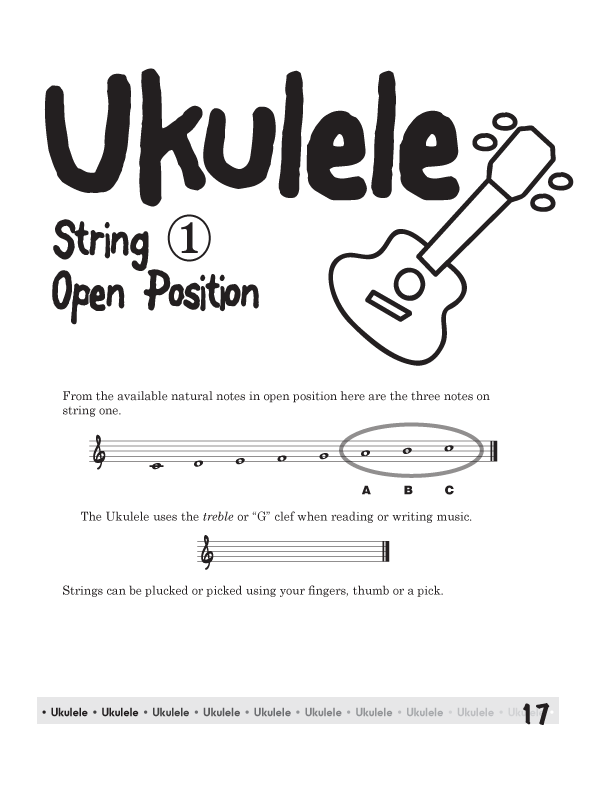
From the available natural notes in open position there are three notes on string one. A, B and C. The Open Position is the open strings and frets one, two, three and four.

From the available natural notes in open position there are three notes on string two. E, F and G.

From the available natural notes in open position there are two notes on string three. C, and D.

Open Position Review - All the natural notes covered on string one, two and three comprise the C Major scale. Here is the fingerboard shape on ukulele.

Learning to read begins with recognizing the notes on the staff and knowing where they are located on the fingerboard. Knowing the name is also a essential skill.

One of the reasons it is hard to read music on the guitar and the ukulele is, alternate note locations. In the open position there is one alternate note location. The open E, string two can also be played on string three, fret (3). If there is no overwhelming musical reason to play one location vs. the other. Then play the one that is easier to play. Use your ear as the final judge as to which one you prefer.

A tie extends the rhythmic value of the first note by the value of the next note. Ties can span multiple notes. Rests are symbols for silence. Each note each has an equivalent symbol for silence.

You can get the fingers working and trained to follow our ear by playing scales, intervals, sequences and arpeggios. These are the four elements used to create melodies and improvisation.

"C Tuning, Low G", extends the melodic range to G below middle C. This expanded range allows for a wider selection when selecting songs to play. The G, A and B are the same names as a high string four but sounding one octave lower.
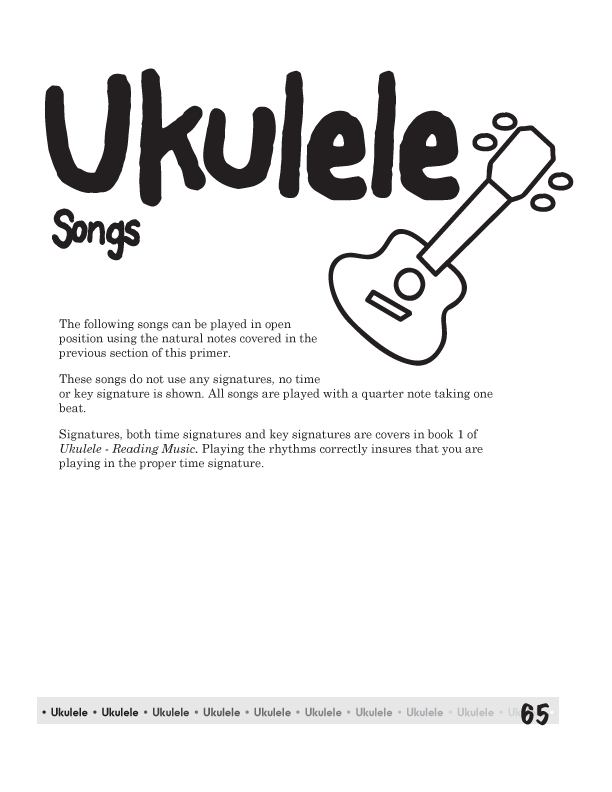
The following songs can be played in open position using the natural notes covered in the previous lessons of this primer. These songs do not use any signatures, no time signature or key signature is shown. All songs are played with a quarter note taking one beat.

It is important to always have your ukulele in tune. This lesson covers the various ways of getting you ukulele in tune.

The Ukulele - Reading Music Series uses the "Modular Phonetic Rhythm System" by Chuck Anderson for learning rhythm.

A chord's name is comprised of it's letter name, either A, B, C, D, E, F, or G and it's type information symbols which encapsulates the instructions for building a chord.

This is a series of lessons for reading music for ukulele at a "Pro" level.

This is a series of lessons for reading music for ukulele at a pro level. Reading can be thought of on many different levels. 1) the ability to slowly and painfully “work out” the written music. 2) the ability to “hear” the music by looking at the notation. 3) the ability to “notate” your ideas in standard music notation. 4) the ability to “read” music as you read a book or an article. 5) the ability to communicate with other musicians in the written language of music. 6) the ability to learn songs that you’ve never heard.

Once you understand the basic concept of reading, it’s time to get down to the development of the skills. We know our goal is to read music as well as we read words. Now, how do we get there? Note Recognition - If you can’t recognize the notes on the staff, you certainly can’t read them. For anyone who is past this step, great! But in many cases, the recognition of notes on the staff is not as good as it should be. If you can’t read music, this skill doesn’t exist at all.

Now that you can recognize the notes on the staff in the Treble clef, it’s time to start connecting that knowledge to the ukulele. One of the most significant problems in reading for the ukulele, is that many of the same notes can be found in multiple locations on the neck. For example, the same A note is an open string one, string two - fret (5) and string three, fret (9) and if using a high G tuning - string four fret (2). The only way to cut down this complexity is to organize the ukulele into positions where this duplication is either eliminated or at least, minimized.

This lessons covers the natural symbol and the sharp key signatures keys. In musical notation, a key signature is a collection of sharp or flat symbols placed together on the staff. Key signatures are generally written immediately after the clef at the beginning of a line of musical notation, although they can appear in other parts of a score, notably after a double barline. A key signature is use to indicate the “auto sharping or flatting of specified notes. Key signatures are also used to identify the key of a composition.
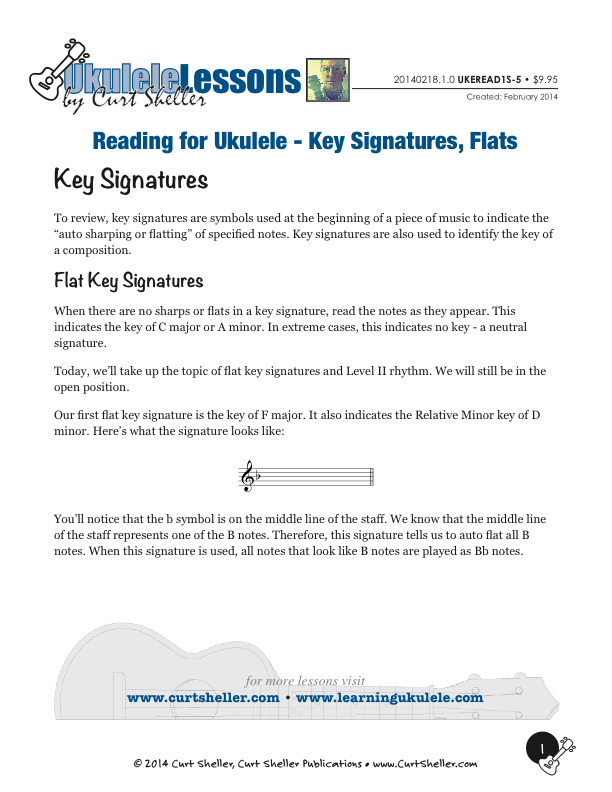
This lessons covers the natural symbol and the flat key signatures keys. In musical notation, a key signature is a collection of sharp or flat symbols placed together on the staff. Key signatures are generally written immediately after the clef at the beginning of a line of musical notation, although they can appear in other parts of a score, notably after a double barline. A key signature is use to indicate the “auto sharping or flatting of specified notes. Key signatures are also used to identify the key of a composition.

This lessons's work will advance rhythm by introducing Ties. Many ukulele players can find the notes on their instrument but can't read rhythm with enough accuracy and speed to be considered "sight readers". Remember that sight reading is just a level of reading. It's not some special and mysterious skill. When you read a book or magazine, you don't have to "work out" the words before you "read" them. You just read them.

Lesson seven covers reading in position II. After spending time on open and first position, we're ready to move into the second position. The second position is defined as the notes on frets 2, 3, 4 and 5 on all four strings.

After spending time on open, first and second position, we’re ready to move into the third position. The third position is defined as the notes on frets 3, 4, 5 and 6 on all four strings.

There are a few things in music that students and players avoid. These are things like learning to read and knowing the notes of their own instrument. It is hard on guitar - but not so hard on ukulele. With the right guidance and plan of attack. IT IS EASY.

Hammer-ons, Pull-offs, and Slides are the most basic embellishments and an integral part of rock, folk, country, bluegrass, and pop music styles.

A metronome is a device that produces an audible click or other sound at a regular interval that can be set by the user, typically in beats per minute (bpm).

Level IV rhythmic syllable pairs for developing your ukulele strums vocabulary and sharpen your reading chops.





.jpg)